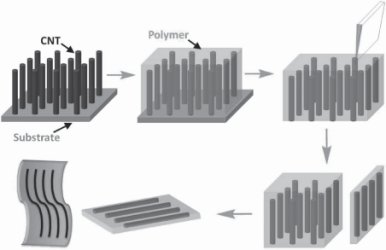For current optoelectronic and electronic devices, electrodes are mainly composed of platinum, indium tin oxide, or both. In addition to their relative scarcity and resultant expense, high-temperature or vacuum processes are typically required to fabricate them, resulting in high production costs. Carbon nanotube (CNT)/polymer composite films represent a promising and low-cost alternative.
Huisheng Peng and co-workers, Fudan University, China, report a new and general approach to make aligned CNT/polymer composite films that are transparent, flexible, and highly conductive. First, high-quality CNT arrays were grown by chemical vapor deposition (pictured). Polymers were then infiltrated into the CNT arrays to prepare composite arrays through solution or melting processes. Finally, the composite arrays were sliced by ultramicrotome or microtome along the CNT-aligned direction.

Compared with traditional methods, this method improves the alignment of CNTs and gives greater control over CNT lengths and structure uniformity as well as the thicknesses of composite films.
Films prepared by this method were used as a counter electrode to fabricate novel dye-sensitized solar cells with high performance as a demonstration of their potential.
Images: © Wiley-VCH
- A New and General Fabrication of an Aligned Carbon Nanotube/Polymer Film for Electrode Applications
Sanqing Huang , Li Li , Zhibin Yang , Lingli Zhang , Hexige Saiyin , Tao Chen , Huisheng Peng
Adv. Mater. 2011.
DOI: 10.1002/adma.201102472



